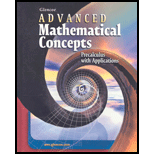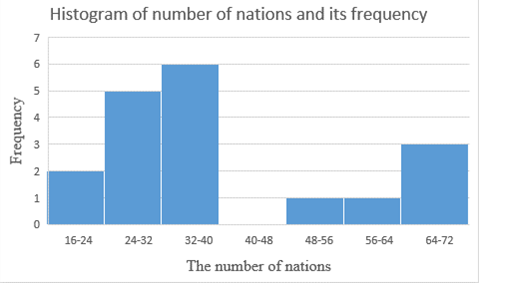
(a)
To find: The range of the first eighteen winter Olympic games.
(a)
Answer to Problem 11E
The range is
Explanation of Solution
Given:
The number of nations:
Concept used:
Calculation:
According to the given in Ascending order is:
To calculate the range of a set of data, subtract the lowest value from highest value.
Hence, the range is
(b)
To find: the appropriate class intervals of first eighteen winter Olympic games.
(b)
Answer to Problem 11E
Class interval is
Explanation of Solution
Given:
The number of nations:
Concept used:
Calculation:
According to the given in Ascending order is:
Class interval can be found by:
Hence, class interval is
(c)
To find: the class limit of a first eighteen winter Olympic games.
(c)
Answer to Problem 11E
Class limits are
Explanation of Solution
Given:
The number of nations:
Concept used:
The class limit are lower limit and upper limit.
Intervals of the class is always same.
Calculation:
According to the given in Ascending order is:
The class limit are lower limit and upper limit of the class size since, the class size is
Hence, the class limits are
(d)
To find: The class marks of first eighteen winter Olympic games.
(d)
Answer to Problem 11E
Class marks are
Explanation of Solution
Given:
The number of nations:
Concept used:
Class marks are the mid value or mid-point of every interval.
Calculation:
According to the given in Ascending order is:
Class marks are the mid value or mid-point of every interval.
Since, class limits are:
For the first interval the class marks:
Similarly, it can be used to find the class mark respective class intervals or add
Hence, class marks are
(e)
To construct: the frequency distribution table for the first eighteen winter Olympic games.
(e)
Answer to Problem 11E
From the frequency distribution tables the frequency can be calculated and total frequency is
Explanation of Solution
Given:
The number of nations:
Concept used:
The frequency distribution table consist of frequency and tally marks which can easily measure the range class limits class size by looking at their respective blocks.
Calculation:
According to the given in Ascending order is:
(f)
To graph: the histogram from the first eighteen winter Olympic games.
(f)
Answer to Problem 11E
From histogram its more cleared to mention the maximum and minimum frequency through which range can be solved.
Explanation of Solution
Given:
The number of nations:
Concept used:
The histogram chart can be draw through Microsoft excel and this histogram chart can give so many information regarding the data.
The histogram is most commonly used graph to show frequency distributions
The purpose of histogram is to graphically summarize the distribution of a univariate data set.
Calculation:
According to the given in Ascending order is:
The histogram chart:

Hence, from histogram its moreclear to mention the maximum and minimum frequency through which range can be solved.
Chapter 14 Solutions
Advanced Mathematical Concepts: Precalculus with Applications, Student Edition
Additional Math Textbook Solutions
Calculus: Early Transcendentals (2nd Edition)
Precalculus (10th Edition)
Thomas' Calculus: Early Transcendentals (14th Edition)
Calculus: Early Transcendentals (3rd Edition)
Precalculus
 Calculus: Early TranscendentalsCalculusISBN:9781285741550Author:James StewartPublisher:Cengage Learning
Calculus: Early TranscendentalsCalculusISBN:9781285741550Author:James StewartPublisher:Cengage Learning Thomas' Calculus (14th Edition)CalculusISBN:9780134438986Author:Joel R. Hass, Christopher E. Heil, Maurice D. WeirPublisher:PEARSON
Thomas' Calculus (14th Edition)CalculusISBN:9780134438986Author:Joel R. Hass, Christopher E. Heil, Maurice D. WeirPublisher:PEARSON Calculus: Early Transcendentals (3rd Edition)CalculusISBN:9780134763644Author:William L. Briggs, Lyle Cochran, Bernard Gillett, Eric SchulzPublisher:PEARSON
Calculus: Early Transcendentals (3rd Edition)CalculusISBN:9780134763644Author:William L. Briggs, Lyle Cochran, Bernard Gillett, Eric SchulzPublisher:PEARSON Calculus: Early TranscendentalsCalculusISBN:9781319050740Author:Jon Rogawski, Colin Adams, Robert FranzosaPublisher:W. H. Freeman
Calculus: Early TranscendentalsCalculusISBN:9781319050740Author:Jon Rogawski, Colin Adams, Robert FranzosaPublisher:W. H. Freeman
 Calculus: Early Transcendental FunctionsCalculusISBN:9781337552516Author:Ron Larson, Bruce H. EdwardsPublisher:Cengage Learning
Calculus: Early Transcendental FunctionsCalculusISBN:9781337552516Author:Ron Larson, Bruce H. EdwardsPublisher:Cengage Learning





